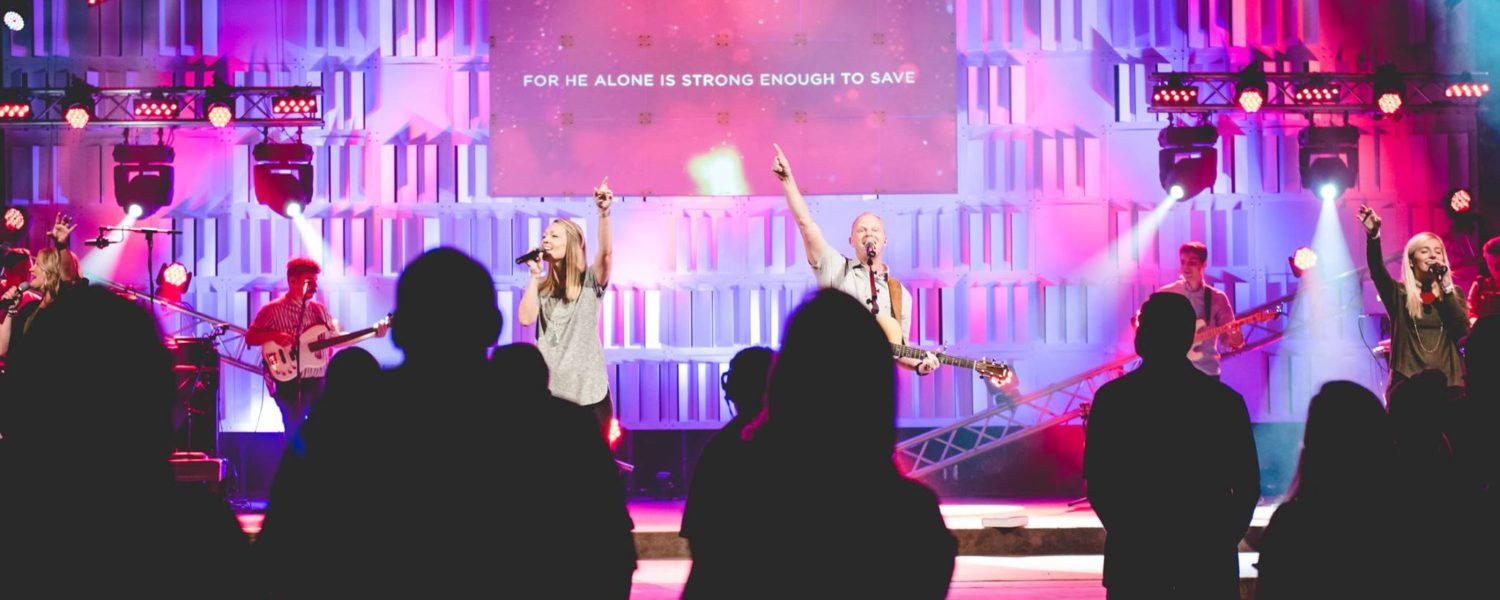By Steven Hall
Creating an excellent atmosphere for worship is pivotal in our new visual culture. Increasingly in our culture, people communicate and connect through visuals in everything they do. Worship is no different. This creates a need in the modern church to create a visual experience in our worship services. We are blessed to be able to create, cultivate, and lead this visual transformation in the church.
With that blessing comes a need for creating visually in the most fitting way. Developing this knowledge of what will work best with your congregation is hugely important. Let’s explore how we can create and serve in the best way for our congregations.
Great design start with knowing the end goal, so we will start with the end in mind! As stage designers in the church, our goal needs to be to create in a way that visually engages our congregation and fits the specific culture of our church.
Culture is the lens we should build our designs around. We should not necessarily look through a lens of the current culture but more specifically the culture our leadership desires to create. Some leaders are great at communicating this goal; others not so much. Either way, it is a great starting place to discuss with your leadership where they see the church going. I find it best to ask the following questions to get a sense of where the church should be headed visually:
- How do you want each service (experience) to feel?
- What kind of energy do you want in worship?
- Do you want worship to feel participatory or introspective?
- Do you want the atmosphere to feel intimate or awe-inspiring?
- Should we value art in our worship?
- How do we want our church family to feel after worship?
From these questions, we can typically figure out how to best create within our space and culture. Having this discussion also communicates to your leadership, that you desire to serve the church more than your own desires. Showing this intention will, over time, create trust with your leadership on how to continually lead your churches visuals toward the goals you and your leadership create.
Let’s take a look at two examples of this conversation and what we can take away as action steps:
Example 1
During a conversation with your senior pastor, you ask him questions about the culture and feel you are trying to create. He communicates that he wants each service to feel intimate. He wants the worship to be energetic at times, but certainly not overwhelming. He wants the worship team to be able to also bring the feel into a more introspective environment on a weekly basis. He likes the current style of two group worship songs followed by an introspective song. He doesn’t think art should be devalued, but he doesn’t really have a plan for how it should be used in worship. He wants the congregation to feel connected to God and their church community after each service.
From this information, we can create a plan that will help our congregation get to its goals. Our design goal should be to create a beautiful atmosphere that helps the congregation connect intimately with God. We should plan to create more of a look and feel than an energetic presentation. We should rely on slow subtle changes that give the room a new feel. We should err on the side of caution when creating a visual that we think may be too bold.
Example 2
Your pastor is super stoked to talk through the stage design. He wants experiences to feel very energetic! He wants the energy from onstage to be contagious to the congregation. He wants a more participatory worship, with a lot of clapping. He values art and thinks it’s a great way to reach some more people, but he admittedly is not an artist. He wants the congregation to feel excited and thrilled to come back next week.
From this conversation, we can develop a plan that will help our congregation hit its goals. Our design goal should be to create an energetic atmosphere. We should match the energy of the worship team with our stage and lighting designs. Bright contrasting lighting will help us to create these bold visuals and communicate energy. Our changes can be quicker and include a more “edgy” feel. We should bring other artists along to help us create things that show our churches value for art. We can give ourselves a bit more freedom with working outside the box.
In both of these situations, there is a need to create a beautiful visual. Both need care and attention to create the best possible outcome. There are some specific elements that need to be included in both instances.
Controllable house lighting should be an essential part of both designs. A moderately high house light level makes it feel easy to connect with others in conversation before service. Moving into the worship component of service, changing the house light levels to be lower is best. It will create an atmosphere where people can feel like they can boldly worship without others “seeing” them.
Onstage lighting is also a huge element. A good stage lighting design helps to support the feel and energy the worship team communicates from the stage. With both designs, there is a need for good front lighting in order to see the worship team. Additionally, good backlighting should be a large part of both designs. Backlighting can be used to communicate emotion and feeling without the distraction of coloring the worship team’s faces. Backlight can also be used directionally to show specifically who is leading or where the focus onstage should be.
Scenic lighting is also an important tool in creating your visuals onstage. Scenic lighting can be simply up lighting the back wall of the stage, lighting a stage set, or use as a direct view lighting fixture. The fixtures used for this are the most important in creating your visual. Since they are not lighting a member of the worship team onstage, you have more flexibility with them. You can create strong color contrasts to communicate emotion. A deep blue and a warm amber used together in this way can create a feeling of intimacy and warmth while providing visual interest.
You can also add effects to the lights when appropriate. A color chase during an energetic song can further encourage your congregation to be excited and participate. You can even turn these lights off at points to create a void that can help communicate the specific feel or direction of a song. This subtraction of light creates a large dynamic, which can be very useful in communicating importance of a particular element or theme.
Scenic lighting can be even more impactful if used in conjunction with scenic elements that are reflective and creative. Using repeating patterns, reflective materials, and textured surfaces can help to get the most out of your lighting and stage design. These types of elements are typically much cheaper than lighting and can give a more artistic feel to your stage.
In addition to the base lighting and scenic, a design can be further enhanced through the addition of side lighting, specials, and colored house lighting. Colored house lighting helps to bring the visual into the room, including not only the stage but the congregation too.
Specials are focusable front lights that have one specific purpose. Typically, they are used to light an individual singer. These specials limit the amount of light pollution from your front light and make the lighting you have onstage seem brighter and more saturated.
Side lighting is great, as well. It more clearly defines shadows onstage. This is true for both the worship team and the scenic elements on the stage. The addition of this colored lighting from the side of the stage helps to add color contrast without washing out the front light, scenic lighting, and back light that the design relies on.
In the first example we explored earlier, we would lean a bit more into our scenic elements to create our visuals. We would use those as our canvas for design. It would not be fitting for us to use a lot of effects or drastic changes. That being said, creating a more low-key design can be more challenging and rewarding. It makes us better designers, as we must spend the time creating the best possible look within the limitations we set forth.
In the second example, we could rely more heavily on lighting. We could use more drastic changes and effects to create our visuals. The key, however, is to do this in a way that is not distracting. Our design should still be supporting the energy of the worship team and not overpowering it. As a rule of thumb, I always ask myself, is this distracting to the congregation worshiping? If I’m not sure, I err on the side of creating something different.
I encourage you to have a conversation with your leadership this week about the direction of your culture. This will revolutionize the way your church does stage design and help you to serve your congregation even better. Figure out the design lens that should be used with your stage, and it will give you an even deeper love of what you are called to do!
Steven Hall serves churches through his company ModScenes.com in Norman, Oklahoma. Through Mod Scenes, Steven and his team create easy-to-use stage designs that are affordable and flexible.

















